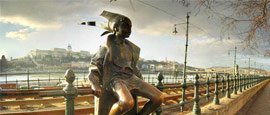Travel to Budapest
Flying to Budapest
Airlines offering flights to Budapest from the UK include British Airways, easyJet, LOT, Ryanair and Wizz Air. You can find cheaper flights in spring, with March, April and May typically the most wallet-friendly times to travel. If booked in advance, June can be inexpensive too. With short breaks to Budapest becoming increasingly popular, weekend travel is best avoided if you're on a budget.
From London - 2 hours 25 minutes; New York - 11 hours (including stopover); Los Angeles - 13 hours 30 minutes (including stopover); Toronto - 10 hours (including stopover); Sydney - 24 hours (including stopover).
Website:https://www.bud.hu
Location:
Budapest Ferenc Liszt International Airport is located 23km (14.3 miles) southeast of Budapest.
Money:
Banking facilities, ATMs and bureaux de change are available in the terminals and the SkyCourt link building.
Luggage:
A lost property service is on hand for enquiries about items lost at the airport (tel: +36 70 332 4006). Luggage lockers are available on the ground floor of the SkyCourt; payment by cash only.
Travel by road
The quality of roads in Budapest is generally good. Traffic drives on the right and the minimum driving age is 17 years. Speed limits are 130kph (80mph) on motorways, 90kph (55mph) on main roads and 50kph (31mph) in built-up areas.
The pink format EU driving licence is accepted, but an International Driving Permit (IDP) is appreciated if you have an older, green UK licence or if you hold a licence from outside the EU. A car registration document, country sticker and third-party liability insurance are compulsory.
Motorway e-vignettes (passes) are required for certain expressways in Hungary, including the M1, M3 and M7. On-the-spot fines are issued for those who travel without one. You must buy these in advance from www.toll-charge.hu.
The Hungarian Automobile Club, Magyar Autóklub (tel: +36 1 345 1800; www.autoklub.hu), has reciprocal agreements with many automobile associations and provides a 24-hour breakdown service.
Magyar Autóklub (tel: 188, in Hungary only).
Hungary has eight main routes, seven of which start from Budapest. Approaching Budapest, the two main highways are the M1 from Györ and Vienna, and the M7 along Lake Balaton. The A4 from Vienna leads to the Austro/Hungarian frontier at Hegyeshalom, where the M1 continues onto Budapest. The M3 connects Budapest with eastern Hungary. Warsaw is reachable on the E77.
From Prague - 5 hours; Vienna - 2 hours 30 minutes; Warsaw - 8 hours 30 minutes.
Volánbusz (tel: +36 1 382 0888; www.volanbusz.hu) operates international services to several countries in Europe, including the UK. International buses leave from Népliget coach station, IX Üllöi út 131.
Volánbusz also operates domestic services to Hungarian towns and resorts. Services to the southwest of the country leave from Népliget coach station, while coaches to the east of Hungary are from Stadion coach station, Hungária körút 48-52. Routes to the Danube Bend depart from Árpád híd coach station, Árboc utca 1-3.
Széna tér coach station, Széna tér, runs routes to the Zsámbéki basin region, while lines to Biatorbágy, Érd, Százhalombatta and surrounding areas leave from Etele tér coach station, Etele tér.
Travel by rail
Rail services from Budapest are relatively clean and modern. IC (InterCity) routes have first-class (elso osztály) carriages and restaurant carts.
There are three, large international railway stations in Budapest: Keleti (eastern station), on VIII Baross tér, Nyugati (western station) at VI Nyugati tér, and Déli (southern station) located at I Krisztina körút. Keleti is the principal terminus for international rail services from Western Europe and Nyugati is the main terminus for trains heading to Eastern Europe.
Direct rail links connect Budapest to plenty of other European cities including Belgrade, Berlin, Bucharest, Krakow, Munich, Prague, Salzburg, Vienna, Warsaw and Zagreb.
Trains are run by Hungarian State Railways (MÁV) (tel: 06 40 494 949, in Hungary only or +36 1 444 4499; www.mav.hu) and reservations are compulsory on IC and IP (InterPici) routes. EC (EuroCity) trains serve domestic destinations and reservations on these are optional.
You can buy tickets for all journeys online at the MÁV website or in person at any of the city’s railway stations. Alternatively, there are a number of outlets selling train tickets around the city. Check the MÁV website for a full list of ticket offices. Reservations for international journeys should be purchased 24 to 36 hours in advance and picked up at the railway station's ticket collection point.
From Debrecen - 2 hours 35 minutes; Szeged - 2 hours 25 minutes; Belgrade - 8 hours; Berlin - 11 hours 50 minutes; Vienna - 2 hours 35 minutes.
Travel over water
From mid-May to September, a hydrofoil ferry connects Budapest and Vienna, Austria. Ferries run three times a week each way.
Boats, which are run by MAHART PassNave (tel: +36 1 484 4013; www.mahartpassnave.hu), dock at the International Landing Stage (Nemzetközi hajóállomás), V Belgrád rakpart, in the heart of the city. The journey takes 6 hours 30 minutes from Budapest to Vienna and 5 hours 30 minutes in the opposite direction.
Do you have any Feedback about this page?
© 2025 Columbus Travel Media Ltd. All rights reserved. No part of this site may be reproduced without our written permission, click here for information on Columbus Content Solutions.








 You know where
You know where